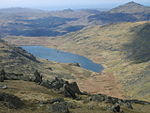Dow Crag
Fells of the Lake DistrictHewitts of EnglandNuttallsSouth Lakeland District

Dow Crag is a fell in the English Lake District near Coniston, Cumbria. The eastern face is one of the many rock faces in the Lake District used for rock climbing. The name Dow Crag originally applied specifically to the eastern face which looks down upon the tarn of Goat's Water, the fell itself having no need for a name before the inception of hill walking in the 19th century. As with many fells the name of a prominent feature was then applied to the whole mass. Dow was originally named Doe and still locally pronounced as "Doe".
Excerpt from the Wikipedia article Dow Crag (License: CC BY-SA 3.0, Authors, Images).Dow Crag
Walna Scar Road,
Geographical coordinates (GPS) Address Website Nearby Places Show on map
Geographical coordinates (GPS)
| Latitude | Longitude |
|---|---|
| N 54.36944 ° | E -3.13744 ° |
Address
Dow Crag Stretcher Box
Walna Scar Road
LA20 6EE , Torver
England, United Kingdom
Open on Google Maps









